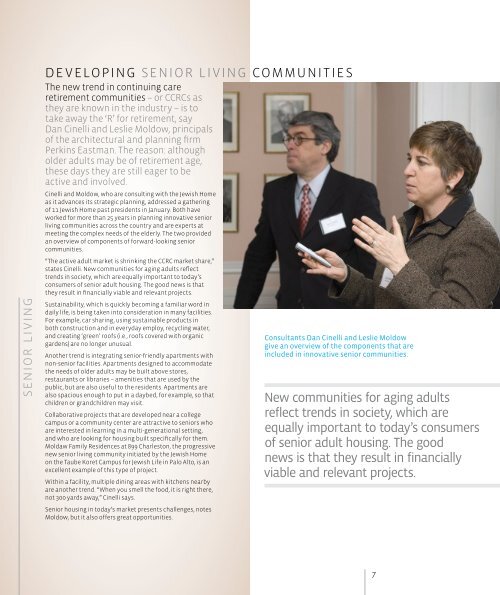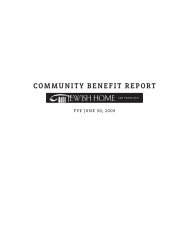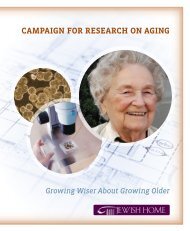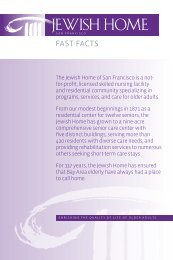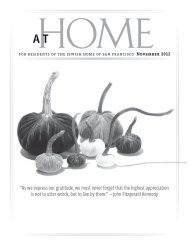It is with tremendous pride th<strong>at</strong> I serve as chair of theJewish Home of San Francisco’s board of trustees. Fornearly 137 years, from one gener<strong>at</strong>ion to the next, theJewish Home has been a vibrant community in whichthe lives of the residents are enriched by the provisionof high quality care, services, and programs.Throughout the Home’s venerable history, the community’sextraordinary commitment to caring for our older adults withdignity and respect has been unwavering. We remain gr<strong>at</strong>eful toour community for this unparalleled level of support. Without it,the Home simply would not be able to provide the level of care andassistance th<strong>at</strong> our community expects and th<strong>at</strong> our residentsdeserve.Yet, in recent years, providing for our community’s older adultshas become increasingly more complex and challenging. The healthneeds of elders are more profound, people are living longer, and thoseseeking our services arrive with gre<strong>at</strong>er frailties than ever before.Government funding is inadequ<strong>at</strong>e and far less dependable as thedifferent levels of government grapple with their own unprecedenteddeficits. In addition, the cost of providing health care continues tomount, while general infl<strong>at</strong>ionary pressures are escal<strong>at</strong>ing <strong>at</strong> r<strong>at</strong>esth<strong>at</strong> are not being m<strong>at</strong>ched by government support.“The intent of this initi<strong>at</strong>ive is to establish aworld-class center for aging services in SanFrancisco th<strong>at</strong> builds upon our reput<strong>at</strong>ionfor innov<strong>at</strong>ion, clinical and service excellence,research, educ<strong>at</strong>ion, and advocacy.”For its part, the Jewish Home’s leadership recognizes the changingworld in which we oper<strong>at</strong>e and is fully poised to dynamically respondto ensure the relevancy and viability of our programs, services, andfacilities throughout the 21st century. It is in this regard th<strong>at</strong> theJewish Home is embarking upon the re-master planning of its SilverAvenue campus. We are analyzing how we deliver services, as wellas our ability to improve and realign these services in a mannerconsistent with trends th<strong>at</strong> meet the current and future projectedneeds of those older adults seeking our services.The intent of this initi<strong>at</strong>ive is to establish a world-class centerfor aging services in San Francisco th<strong>at</strong> builds upon our reput<strong>at</strong>ionfor innov<strong>at</strong>ion, clinical and service excellence, research, educ<strong>at</strong>ion,and advocacy. The scope of this project will include but not belimited to: a facilities and building systems review; environmentalanalysis; demographic analysis; and community needs assessment.Additionally, we are collabor<strong>at</strong>ing with our Menorah Park of SanFrancisco partners in order to identify ways to extend our services tothose older adults who do not require medically-oriented services,David friedmanyet desire the convivial <strong>at</strong>mosphere of a Jewishsponsoredolder adult community. The JewishHome’s site re-master plan project is led by animpressive Steering Committee comprised of JewishHome trustees and staff, as well as communityrepresent<strong>at</strong>ion. In partnership with the Home’ssenior staff, I would like to take this opportunity toacknowledge and thank the following individualsfor serving with me on this committee: MichaelAdler, James Davis, David Friedman, Bill Pomeranz,Nurit Robinson, Joel Roos, and Michael Strunsky.I look forward to working with this outstandingcommittee and keeping you apprised of ourprogress.The Jewish Home of San Francisco remains theflagship – the emotional and cultural epicenter ofour aging initi<strong>at</strong>ives. The hallmark of the JewishHome over its long history has been the ability tore-invent itself, ensuring relevancy to its clients.As we continue this evolutionary process, we do soknowing th<strong>at</strong> opportunities can only be optimizedthrough your continued generous support.Mark MyersChair, Board of Trustees,Jewish Home of San FranciscoMark Myers6 Jewish Senior Living summer 2008
senior livingDEVELOPING SENIOR LIVING COMMUNITIESThe new trend in continuing careretirement communities – or CCRCs asthey are known in the industry – is totake away the ‘R’ for retirement, sayDan Cinelli and Leslie Moldow, principalsof the architectural and planning firmPerkins Eastman. The reason: althougholder adults may be of retirement age,these days they are still eager to beactive and involved.Cinelli and Moldow, who are consulting with the Jewish Homeas it advances its str<strong>at</strong>egic planning, addressed a g<strong>at</strong>heringof 11 Jewish Home past presidents in January. Both haveworked for more than 25 years in planning innov<strong>at</strong>ive seniorliving communities across the country and are experts <strong>at</strong>meeting the complex needs of the elderly. The two providedan overview of components of forward-looking seniorcommunities.“The active adult market is shrinking the CCRC market share,”st<strong>at</strong>es Cinelli. New communities for aging adults reflecttrends in society, which are equally important to today’sconsumers of senior adult housing. The good news is th<strong>at</strong>they result in financially viable and relevant projects.Sustainability, which is quickly becoming a familiar word indaily life, is being taken into consider<strong>at</strong>ion in many facilities.For example, car sharing, using sustainable products inboth <strong>construction</strong> and in everyday employ, recycling w<strong>at</strong>er,and cre<strong>at</strong>ing ‘green’ roofs (i.e., roofs covered with organicgardens) are no longer unusual.Another trend is integr<strong>at</strong>ing senior-friendly apartments withnon-senior facilities. Apartments designed to accommod<strong>at</strong>ethe needs of older adults may be built above stores,restaurants or libraries – amenities th<strong>at</strong> are used by thepublic, but are also useful to the residents. Apartments arealso spacious enough to put in a daybed, for example, so th<strong>at</strong>children or grandchildren may visit.Collabor<strong>at</strong>ive projects th<strong>at</strong> are developed near a collegecampus or a community center are <strong>at</strong>tractive to seniors whoare interested in learning in a multi-gener<strong>at</strong>ional setting,and who are looking for housing built specifically for them.Moldaw Family Residences <strong>at</strong> <strong>899</strong> <strong>Charleston</strong>, the progressivenew senior living community initi<strong>at</strong>ed by the Jewish Homeon the Taube Koret Campus for Jewish Life in Palo Alto, is anexcellent example of this type of project.Within a facility, multiple dining areas with kitchens nearbyare another trend. “When you smell the food, it is right there,not 300 yards away,” Cinelli says.Senior housing in today’s market presents challenges, notesMoldow, but it also offers gre<strong>at</strong> opportunities.Consultants Dan Cinelli and Leslie Moldowgive an overview of the components th<strong>at</strong> areincluded in innov<strong>at</strong>ive senior communities.New communities for aging adultsreflect trends in society, which areequally important to today’s consumersof senior adult housing. The goodnews is th<strong>at</strong> they result in financiallyviable and relevant projects.7


